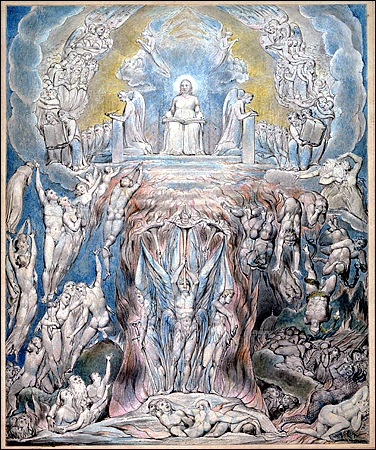William Blake – the 18th century artist – had an unusual way of seeing and painting the world.
Rather than following the expectation for naturalistic realism prevalent in his day, Blake’s paintings tried to bring unseen spiritual realities into visual focus through the inclusion of striking, often literally impossible details. The result was more faithful, he thought, to reality in all its very real spiritual depths. Many around him disagreed and complained about his (to their eyes) overly spiritualized and fantastical style. When one of his paintings was criticized along just these lines, Blake replied:
“What,” it will be Questioned, “When the Sun rises do you not see a round Disk of fire somewhat like a Guinea?”
“O no, no! I see an Innumerable company of the Heavenly host crying, Holy, Holy, Holy is the Lord God Almighty! I question not my Corporeal or Vegetative Eye any more than I would Question a Window concerning a Sight; I look thro it and not with it.”1

What William Blake saw in every sun rise. (Footnote 2)
What do you see when you look at the sun? Just a big ball of fire a long way away in a cold and mostly empty cosmos? Or do you see a celestial sphere burning with the glory of God and declaring his splendor? The sun is a big ball of fire, yes. But it is more – irreducibly more.
The sun is an image of God’s life-giving radiance, a sign of his warm and illuminating brilliance. It is the material reverberation of a word spoken by God’s Word, through whom and for whom all things have been made. The sun speaks, and if we can hear it, what it speaks is Christ.
You and I – and every blade of grass on the earth and every star in the sky – is more than it at first might seem to be. The sun is a yellow orb in a way that anyone can see, but it is an image of God’s radiance, of Jesus Christ, only for those with eyes to see. Everyone who passes by a dirty beggar on the corner can year her mumbled request for help, but only those who’ve gained Jesus’ ears will hear his song in her sad refrain.
The question is, how do you acquire such eyes and ears?
How do you acquire the mind of Christ?
Seeing More Than a Man
This question, I think, is the key hermeneutical3 question posed by Jesus (and his apostles after him) in the New Testament. Many people looked at Jesus during his earthly sojourn, but few adequately saw him as the divine One he truly is. They saw a man, a Galilean peasant-preacher. Some of them saw a prophet. Some saw a meal ticket. Some saw a false teacher leading the people astray. A small number of people saw God’s Messiah, but even these few disciples did not perceive well what their own confession meant.
Only later, in the light of the resurrection, would Jesus’ friends and followers come to see him clearly, not just as a man, but as God-in-the-flesh. Only from that perspective was the Messiah seen with clarity. Only once the resurrected Jesus could walk and talk with his followers, open the Scripture for them, and help them see it from this post-resurrection vantage point, could they grasp that God’s Messiah had always been meant to fight a spiritual, not an earthly battle.
People during Jesus’ earthly ministry looked and looked, but they didn’t truly see him as he was in all his infinite depths. They saw a mere human, not the Word and Son, the Wisdom and Power of God. Nor could people with mere earthly sight perceive in Jesus’ grisly crucifixion the grand plan of God’s salvation.
But this is no surprise.
When God spoke from heaven over Jesus, many only heard a bit of thunder. When the Spirit descended at Pentecost, some saw a miracle, but others only saw evidence of early drinking!
So much depends on gaining from Jesus eyes to see and ears to hear. Only those who have received such eyes and such ears from Jesus will be able to see the Divine Word in the man Jesus, God’s plan in the chaos of human history, and the Spirit (which makes alive) in the letter of the Law (which, by itself, kills).
Scripture, a Portrait of Jesus
Spiritual things – including Scripture – must be spiritually discerned. We come to understand Scripture well only as we learn from Jesus how to see Jesus in every word. He heals our vision as we walk with him and our fellow disciples, as we break bread together, as we practice his way together, as we pray over the Scriptures and appropriate them as our way of praying.
When people read the Bible apart from Jesus, a veil covers its true meaning. The glory of the Bible – which is nothing other than the face of Jesus – is obscured by that veil. But when we turn to the Lord, the veil is removed, and we behold the glory of God in the face of Jesus Christ looking back out at us through the letters on the physical page before us.
Every word of Scripture – every jot and tittle – is part of a portrait of Jesus’ face and shines with the light of his goodness. As such, we perceive Scripture well only when we have come to perceive it as a depiction of Jesus. If we look from a merely human point of view, trying to measure out the Scriptures as we would any merely human text, we will miss their divine significance just as people in Jesus’ day missed God in the man.
In the impact seminar I’m leading this fall, “Reading with Jesus: A Brethren in Christ Approach to Biblical Hermeneutics,” I will not be offering a method of textual interpretation. Instead, I will share ruminations on the sort of spiritual perception which allows us to see these divine words in all their divine, Jesus-shaped depths.
We will explore how Jesus and various New Testament authors teach us to see the Scriptures. We will explore what a hermeneutic focused on the spiritual perception of Jesus practically entails. And together we will practice such reading, bending over God’s word side-by-side.
In particular, we will practice this sort of reading together as we seek God’s wisdom regarding two crucial matters: violence and sex.
There is a lot to cover on these two topics in one day! We will only be able to skim the surface of what is, in truth, a vast ocean. But what a joy it will be to contemplate, even so briefly together, the depths of the riches and the wisdom and the knowledge of God which may be seen in the face of Jesus Christ as his face appears before us in the pages of holy Scripture!
Zach will lead the “Reading with Jesus” seminar in six different locations this fall. This is a free event, but registration in required at least one week before a seminar begins.
Footnotes
- From “A Vision of the Last Judgement,” in William Blake, The Complete Poetry and Prose of William Blake, Newly re. ed., 5. print, ed. David V. Erdman (Anchor Books Doubleday, 1988), 565–66.
- William Blake, The Day of Judgement, Public domain, via Wikimedia Commons. One of Blake’s watercolor illustrations for Robert Blair’s poem The Grave.
- Hermeneutic – noun: a method or theory of interpretation; adjective: concerning interpretation, especially of the Bible or literary texts.


